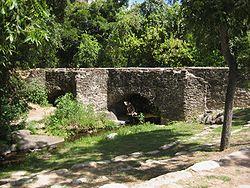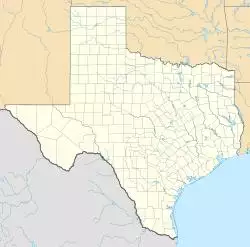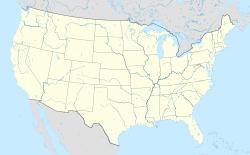Espada Aqueduct | |
U.S. Historic district Contributing property | |
 The Espada aqueduct as it crosses Piedras Creek. | |
| Location | Espada Rd., E of U.S. 281S |
|---|---|
| Nearest city | San Antonio, Texas |
| Coordinates | 29°18′16.4″N 98°28′10″W / 29.304556°N 98.46944°W |
| Built | 1731[1] |
| Part of | San Antonio Missions National Historical Park (ID78003147) |
| NRHP reference No. | 66000809 |
| Significant dates | |
| Added to NRHP | October 15, 1966[1] |
| Designated NHL | July 19, 1964[2] |
| Designated CP | October 6, 1975[3] |
The Espada Acequia, or Piedras Creek Aqueduct, was built by Franciscan friars in 1731 in what is now San Antonio, Texas, United States. It was built to supply irrigation water to the lands near Mission San Francisco de la Espada, today part of San Antonio Missions National Historical Park. The acequia is still in use today and is an Historic Civil Engineering Landmark and a National Historic Landmark.
Irrigation system
Mission Espada's acequia (irrigation) system can still be seen today. The main ditch, or acequia madre, continues to carry water to the mission and its former farmlands. This water is still used by residents living on these neighboring lands.
The initial survival of a new mission depended upon the planting and harvesting of crops. In south central Texas, intermittent rainfall and the need for a reliable water source made the design and installation of an acequia system a high priority. Irrigation was so important to Spanish colonial settlers that they measured cropland in suertes -the amount of land that could be watered in one day.
The use of acequias was originally brought to the arid regions of Spain by the Romans and the Moors. When Franciscan missionaries arrived in the desert Southwest they found the system worked well in the hot, dry environment. In some areas, like New Mexico, it blended in easily with the irrigation system already in use by the Puebloan Native Americans.
In order to distribute water to the missions along the San Antonio River, Franciscan missionaries oversaw the construction of seven gravity-flow ditches, dams, and at least one aqueduct—a 15-mile (24 km) network that irrigated approximately 3,500 acres (14 km2) of land. The acequia not only conducted potable water and irrigation, but also powered a mill.
Mission Espada has survived from its beginnings to the present day as a community center that still supports a Catholic parish and religious education, however a school originally opened by the Sisters of the Incarnate Word and Blessed Sacrament was closed in 1967.
References
- ^ a b "National Register Information System". National Register of Historic Places. National Park Service. April 15, 2008.
- ^ "Espada Aqueduct". National Historic Landmark summary listing. National Park Service. Archived from the original on 2009-10-12. Retrieved 2008-06-26.
- ^ Texas Historic Atlas
External links
- Historic American Buildings Survey (HABS) No. TX-322, "Aqueduct, San Antonio, Bexar County, TX", 5 photos, 2 data pages
- Historic American Engineering Record (HAER) No. TX-1-A, "Espada Acequia, Piedras Creek Aqueduct, Spanning Piedras Creek east of Espada Road, San Antonio, Bexar County, TX", 3 photos, 1 measured drawing, 1 photo caption page
- HAER No. TX-1-B, "Espada Acequia, Diversion Dam", 1 photo, 1 measured drawing, 1 photo caption page

